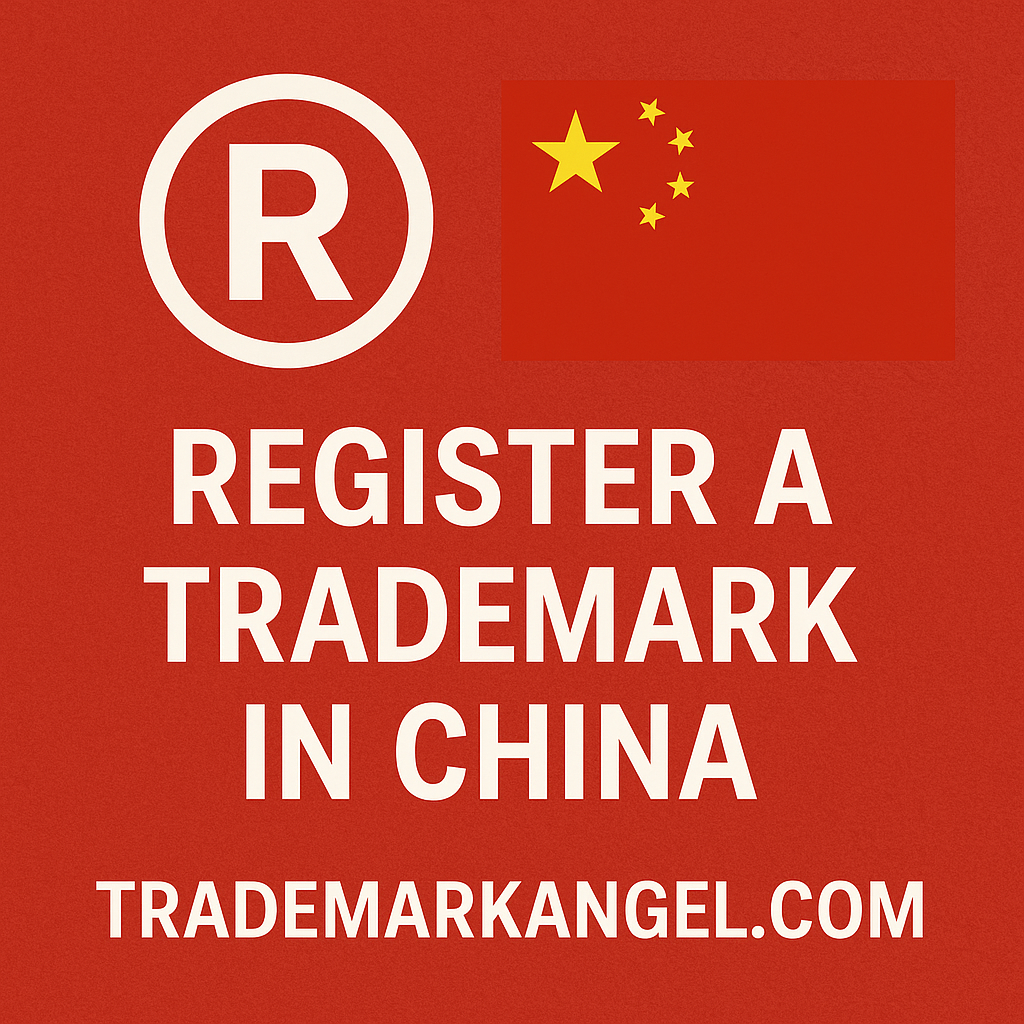The Canadian Intellectual Property Office (CIPO) has recently embarked on improving its services. The Trademarks Office and Trademarks Opposition Board launched a new online service called the Trademark Document Retrieval Service (TDRS) and will be sending Office correspondence electronically. Previously, the CIPO has sent correspondence by mail that takes weeks before it is received by applicants and/or agents. With the switch to electronic correspondence, the processing of trademark applications will become faster and the instances of lost mail/correspondence will be avoided. The TDRS is a more stable and performant cloud infrastructure. It is similar to the US Patent and Trademark Office’s Trademark Status & Document Retrieval (TSDR). The CIPO’s TDRS will now allow trademark documents to be viewed online in addition to the public records and details of Canadian trademarks. As an example, you may view this trademark, filed in June 2024 and already registered in October 2024 (after we filed a petition to expedite registration):
You simply need to click “Documents” to see the trademark documents made available online to the public. With these changes, drastic improvements in CIPO’s trademark services are expected.
To open in a new tab, click: Changes and Improvements with CIPO’s Trademark Correspondence and Online Database
CIPO currently charges government fees per class:
• C$478.15 for the first class (approx. $330), and
• C$145.12 for each additional class (approx. $100).
However, in the Canadian government fees are calculated differently from other countries even though they are charged per class. What does it mean?
For example, let's say you filed an application in 2 classes:
Class 28: Toys and Class 25: Clothing (and by mistake you also put “watches” in class 25 not realizing they actually belong to class 14.). You paid the government fees for 2 classes (C$478.15+C$145.12 ) and the application is going into the examination. Once the application is examined, a CIPO examiner will determine if your original choice of classes was correct. In this case, he/she will tell you that Watches belong to class 14. So, you’ll have to pay for an additional fee (C$145.12) for adding the 3rd class, EVEN IF YOU DECIDE TO DELETE IT. Simply deleting it will not avoid having to pay the extra government fee.
This is how Canada is different from the US, EU, UK, Germany, and many other countries and a Canadian application filed incorrectly or without a careful selection of classes may end up very expensive.
The takeaway:
It's best to use a pre-approved list of goods and services to avoid surprises like this and having to pay extra in government fees.
To open in a new tab, click: How Canadian government fees will be calculated once your trademark is examined?
A Power of Attorney, POA in short, is a legal document that authorizes an entity to represent or act for another person, usually, in the managing of the person’s property, business or private affairs. The former is called the Attorney or Agent whereas the latter is commonly known as the Principal.
In Trademarks, a Power of Attorney is required to appoint an Attorney on your file so he/she can represent you before the respective Trademarks Office.
Having said that, in many countries including the US, UK, Europe, Canada and Australia you don’t need to sign a POA for a standard trademark application (power of attorney is already implied when you entrusted your attorney/agent trademark registration). However, there are countries, such as, China, Mexico, Russia and India where a POA signed by the owner or any other person legally bound to the owner is required in order to file a trademark application.
In the US, when an applicant wishes to replace its existing attorney and appoint a new attorney, it needs to sign a Power of Attorney authorizing the new attorney to prosecute the trademark application.
To open in a new tab, click: What is a power of attorney? When do I need to sign a power of attorney?
Trademarks in Canada have to be renewed every 10 years from the registration date.
Note: this is different from many other countries, like UK or EU for example, where renewal period is counted from the filing date. Since Canadian trademark registration process is rather long, we can understand why the renewal period is counted from the registration date.
To open in a new tab, click: How often do I have to renew my Canadian trademark?
Sometimes filing a trademark application is not advisable. Please read below when you should not file in Canada.
- If you are trying to get into Amazon Brand Registry, Canada is not the best choice since trademark registration takes up to 26 months in Canada.
- If there is a similar trademark already or you are aware of a competitor who is selling under a similar name. In this case, consider making some changes to your trademark or re-brand completely.
- Please do not submit your trademark application without an adequate trademark search.
- If your trademark is generic, descriptive, or immoral, it should not be filed as your trademark will not be registrable.
- If you are a very small business, filing a trademark application may be unnecessary.
- Finally, if your main market is in the US, for example, filing in Canada will not protect you in the US as trademarks are jurisdictional.
To open in a new tab, click: When should I stay away from filing a trademark in Canada?
There are 3 ways how you can proceed:
- Book an initial phone call with us. Here is the link for the trademark package
- Ask for a free preliminary trademark search to get an idea of whether your trademark can be registered. This is a basic search but if your mark is unregistrable, we'll be able to tell you. Order your search here.
- Buy a trademark package right away to start the trademark registration process without further delay. You can see our pricing on this page and can buy directly from our website.
What happens after I buy a trademark package?
- We'll confirm your order.
- We'll check if your trademark is registrable. A comprehensive trademark search will be done at this stage. We will provide detailed recommendations on how to increase the chances of achieving registration if your trademark turns out to be problematic.
- If your trademark is registrable, we'll move forward with the trademark registration process.
- If your trademark has low chances of achieving registration, you will have 3 options:
- Ask for a full refund;
- Come up with a different name. We will provide detailed instructions for this. Further trademark searches are included in the package and there is no extra cost. We'll keep searching until we find a registrable trademark;
- Proceed with the filing anyway.
The choice is yours. Make the first step now.
To open in a new tab, click: How does the process work with Trademark Angel? What happens after I buy a trademark package?
Trademark Classes
Every trademark application must list the specific goods and services that the trademark will cover.
Products belong to trademark classes 1 to 34. Services belong to classes 35 to 45.
Products are tangible, you can touch them. Services are intangible.
Below is a rough classification (class headings) just to give you an idea of general categories (please note that the below list cannot be used for trademark filing)
Products
Class 1: Chemicals (including those used in agriculture, industry and science)
Class 2: Paints, coatings, varnishes, colorants for food.
Class 3: Cosmetics, creams and serums, cleaning products including soap and shampoo, bleaching and abrasives, non-medicated toiletry preparations, false eyelashes, essential oil, perfume
Class 4: Fuels, industrial oils, greases, lubricants, candles
Class 5: Pharmaceutical and veterinary products, food supplements and vitamins, baby food, disinfectants, fungicides, herbicides, plasters, dental wax
Class 6: Metals, metal castings, metal hardware, metal containers, locks, safes
Class 7: Machines and machine tools and their parts, motors and engines (except for land vehicles)
Class 8: Hand-operated tools and implements, razors, cutlery
Class 9: Computers, computer hardware, computer cables, cell phones and cell phone cases, data carriers, computer software, downloable publications including e-books, videos and podcasts
Class 10: Medical and dental instruments and apparatus, massage apparatus, sex toys
Class 11: Products for lighting, heating, steam generating, cooking, refrigerating, drying, ventilating, water supply and sanitary purposes including lamps and kettles
Class 12: Land, air and nautical vehicles, motors and engines for land vehicles
Class 13: Firearms, ammunition, explosives, fireworks, holsters
Class 14: Precious metals, watches, jewellery
Class 15: Musical instruments
Class 16: Paper, items made of paper, stationery products, artists’ products, printed products including photographs, stickers, notebooks, party ornaments of paper
Class 17: Rubber, asbestos and plastic Items, pipes and tubes
Class 18: Leather and leather goods, bags, wallets, animal apparel, collars and leashes for animals
Class 19: Building and construction materials (non-metallic), non-metal monuments
Class 20: Furniture, mirrors, picture frames, storage containers not of metal, party ornaments of plastic
Class 21: Kitchen utensils, crockery, containers, cleaning implements, toothbrushes
Class 22: Ropes and strings, tents, nets, awnings, sacks, padding, canvas material and raw fibrous textile material
Class 23: Yarns, threads
Class 24: Textiles, fabrics, blankets, covers, towels
Class 25: Clothing, footwear and headgear
Class 26: Sewing products, lace and embroidery, artificial flowers, hair decorations like ribbons, false hair
Class 27: Carpets, linoleum, wall and floor coverings, wall hangings
Class 28: Sports equipment, video game apparatus, games, toys, Christmas decorations
Class 29: Dairy products, meat and fish, processed and preserved foods, including dried, frozen and cooked fruits and vegetables, milk, eggs, edible oils and fats, jamps, jellies
Class 30: Staple foods, spices, bakery products, confectioneries, tea, coffee
Class 31: Fresh fruit and vegetables, live animals, animal food, seeds, fresh herbs, plants and flowers
Class 32: Non-alcoholic beverages, preparations for making beverages, fruit juices, beer
Class 33: Alcoholic beverages, except beer
Class 34: Tobacco products and smokers’ articles, matches, electronic cigarettes
Services
Class 35: Retail services including online retail store, advertising, business consulting, business management
Class 36: Insurance and financial services, real estate services
Class 37: Building construction, repair and maintenance services, installation services
Class 38: Telecommunication services, broadcasting services including video broadcasting
Class 39: Transport, logistics and storage, travel services
Class 40: Treatment of materials, custom assembly, recycling and waste management
Class 41: Education services, including arranging and conducting educational classes and seminars, entertainment services, book publishing, organizing exhibitions and conferences
Class 42: Saas and Paas services (Software as a service and platform as a service), IT services, software development, graphic design services, website development, scientific and technological services
Class 43: Restaurants, cafes, hotels, catering services
Class 44: Medical services, hygienic and beauty care services, dental services, veterinary services
Class 45: Personal and social services, legal services, security services
For a more in-depth discussion read this article: Taking Advantage of the Trademark Classification
To open in a new tab, click: Classification of Goods and Services in a Trademark Application (class headings)
When deciding whether to file for either a word mark or logo, it is important to keep in mind that a logo must always be used as it is depicted in your application. In addition, if you file your logo in a particular color in the US, you must always use your logo in that particular color.
On the other hand, word marks are somewhat more flexible. When filed in all capital letters, word marks allow the trademark owner to display it in any combination of lower case and upper case letters.
For example, if you filed for the word mark TRADEMARK ANGEL ROCKS, you can use it on your goods and/or services as: trademark angel rocks, Trademark Angel Rocks, or TraDeMaRk AnGeL RoCkS.
The flexibility of a word mark ultimately makes it quite appealing as it is not limited to a particular font or color and can be displayed in a combination of upper and lower-case letters.
However, filing for a logo can be more advantageous in some situations.
For example, if your mark is found to be descriptive of your goods/services or uses generic words, your mark will generally be limited to the Supplemental Register. A distinct logo, however, can “carry” the mark to the Principal Register despite the descriptive nature of your mark.
Let’s say you want to file for TRADEMARK REGISTRATION CO. for a company that offers trademark registration services. That’s a mark that is descriptive of the services offered, and will therefore would be limited to registration to the Supplemental Register. If this same mark was filed with a distinctive logo, for example:
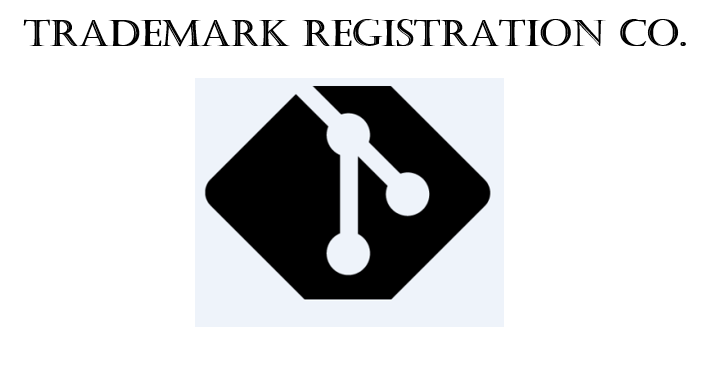 Then, the logo could provide sufficient distinctiveness to allow registration of TRADEMARK REGISTRATION CO. onto the Principal Register (with a disclaimer for “TRADEMARK REGISTRATION CO.”).
Another situation when filing for a logo is advantageous is when there are similar marks. For example, a client wanted to register the mark HAWQUE with a design element of a flying hawk
Then, the logo could provide sufficient distinctiveness to allow registration of TRADEMARK REGISTRATION CO. onto the Principal Register (with a disclaimer for “TRADEMARK REGISTRATION CO.”).
Another situation when filing for a logo is advantageous is when there are similar marks. For example, a client wanted to register the mark HAWQUE with a design element of a flying hawk 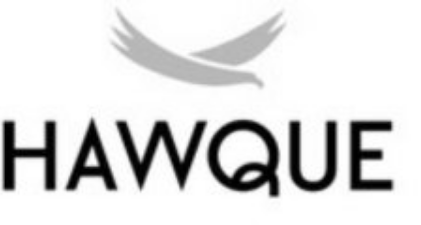 - for computer software connecting customers to security contractors, in Class 9. We advised that the logo will most likely be registrable but the wordmark alone would be too similar to marks containing the word HAWK providing similar products in the same class. Although we received an office action alleging that the HAWQUE logo mark was confusingly similar to a registered wordmark, HAWQ, that also covered Class 9 computer software, we were ultimately able to overcome the objection. Our client’s logo, HAWQUE, was successfully registered soon after.
In another case, a client wanted to register the mark ESTEEM APPAREL, either the word mark or the logo. However, in our initial search, we found a very similar, registered mark, ESTEEM CLOTHING. In this case, we advised that the logo would have a greater chance of registration. The client chose to file for the logo
- for computer software connecting customers to security contractors, in Class 9. We advised that the logo will most likely be registrable but the wordmark alone would be too similar to marks containing the word HAWK providing similar products in the same class. Although we received an office action alleging that the HAWQUE logo mark was confusingly similar to a registered wordmark, HAWQ, that also covered Class 9 computer software, we were ultimately able to overcome the objection. Our client’s logo, HAWQUE, was successfully registered soon after.
In another case, a client wanted to register the mark ESTEEM APPAREL, either the word mark or the logo. However, in our initial search, we found a very similar, registered mark, ESTEEM CLOTHING. In this case, we advised that the logo would have a greater chance of registration. The client chose to file for the logo 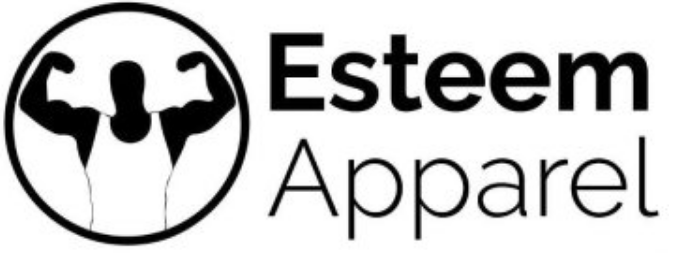 instead of the word mark and, although we received a confusion objection based on similarity with ESTEAM and ESTEEM CLOTHING marks, we were able to successfully able to overcome the objection and the mark was successfully registered.
Since the client protected the logo
instead of the word mark and, although we received a confusion objection based on similarity with ESTEAM and ESTEEM CLOTHING marks, we were able to successfully able to overcome the objection and the mark was successfully registered.
Since the client protected the logo  , he now cannot use Esteem Apparel side by side, without the image, in a different font or in ALL CAPITAL letters: ESTEEM APPAREL. On the other hand, if word mark had been filed - ESTEEM APPAREL, he could have used it in ALL CAPITAL LETTERS, in any font, side by side or one word above the other. Logo makes the trademark inflexible and you should not be making even small changes in your use.
In addition, in some cases, one has to file for a logo if the trademark is broken/separated by images or symbols. Please check our article that talks more about it.
Thus, as can be seen from the above examples, it is important to first determine if your mark is too descriptive to achieve registration in the Principal Register, and whether you intend to consistently display your logo on all of your products, prior to making a decision regarding whether to file for a word mark or a logo. Also, in case there are similar marks, filing for the logo may help to differentiate and ultimately achieve registration of your mark.
, he now cannot use Esteem Apparel side by side, without the image, in a different font or in ALL CAPITAL letters: ESTEEM APPAREL. On the other hand, if word mark had been filed - ESTEEM APPAREL, he could have used it in ALL CAPITAL LETTERS, in any font, side by side or one word above the other. Logo makes the trademark inflexible and you should not be making even small changes in your use.
In addition, in some cases, one has to file for a logo if the trademark is broken/separated by images or symbols. Please check our article that talks more about it.
Thus, as can be seen from the above examples, it is important to first determine if your mark is too descriptive to achieve registration in the Principal Register, and whether you intend to consistently display your logo on all of your products, prior to making a decision regarding whether to file for a word mark or a logo. Also, in case there are similar marks, filing for the logo may help to differentiate and ultimately achieve registration of your mark.
To open in a new tab, click: Which trademark should I File? Word Mark or Logo?
What is the difference between company name, business name, domain name and brand or trademark?
What are different types of company, domain, business or brand names? Let's get the names straight to avoid confusion.
- Company name: Legal name of the company, either registered federally or in a certain state (or province in Canada).
Example: Microsoft Corporation
Note: one company may own more than one brand and may do business under more than one name
- Business name or doing business as: Name under which you conduct your business.
Example: Microsoft
Example: Skype
- Domain name: Name of your address on the Web.
Example: www.microsoft.com
Example: www.skype.com (Microsoft owns Skype)
- Trademark: A trademark may be one word, a combination of words, or logos (or even sounds and smells!) used to distinguish/differentiate your products or services from those of other entities.
Example: MICROSOFT,  , or a combined mark:
, or a combined mark:  Example: SKYPE,
Example: SKYPE,  Let's take another example of a giant retailer Kraft Foods.
Company name: Kraft Foods Inc.
12 of Kraft Foods brands are sold worldwide: Cadbury, Jacobs, Kraft, Maxwell House, Milka, Nabisco, Oreo, Oscar Mayer, Philadelphia, Trident and Tang.
For each brand Kraft Foods has a website: cadbury.co.uk; cadbury.com.au; oreo.com; oscarmayer.com, etc.
Not everyone knows that these 12 famous brands are owned by the same giant! It doesn't really matter, what matters is that everyone knows where do buy their favorite Cadbury chocolate or Oreo cookies and everyone knows how the Oreo cookies package looks like!
Let's take another example of a giant retailer Kraft Foods.
Company name: Kraft Foods Inc.
12 of Kraft Foods brands are sold worldwide: Cadbury, Jacobs, Kraft, Maxwell House, Milka, Nabisco, Oreo, Oscar Mayer, Philadelphia, Trident and Tang.
For each brand Kraft Foods has a website: cadbury.co.uk; cadbury.com.au; oreo.com; oscarmayer.com, etc.
Not everyone knows that these 12 famous brands are owned by the same giant! It doesn't really matter, what matters is that everyone knows where do buy their favorite Cadbury chocolate or Oreo cookies and everyone knows how the Oreo cookies package looks like!
To open in a new tab, click: What are different types of names? Company name vs business name vs domain name vs trademark?
If you simply business incorporate or register a corporate name, it doesn't mean that the government approved for you to use the name as a trademark.
If we take a US LLC, as an example, every state has its own laws about business names.
You can register your LLC name in Delaware but the business name registration has no impact on the other 49 states.
In plain English, if you register Coolapples LLC in Delaware, another entity may register Coolapples LLC in Indiana. If you plan to expand nationwide or worldwide, trademark registration will provide that protection. A federal US trademark will give you exclusive rights to use your brand name for your products across the US. Likewise, a Canadian or Australian trademark will give you country-wide rights to use your chosen brand in your country and will make it easier for your to sell or license your trademark later.
To open in a new tab, click: Do I need to register a trademark if my business incorporated?
In Canada, use is no longer required for filing or registration. In fact, filing bases have been completely eliminated. No specimens of use or statements of use are necessary.
Use is mandatory to maintain your trademark after registration. It is possible to cancel a trademark for non-use if the trademark has not been in use for 3 years after registration and there has been no good reason to justify non-use.
To open in a new tab, click: Do I have to use my trademark prior to filing in Canada? Do I have to use my trademark after registration?
It’s perfectly legal for you to use your trademark without registration. However, if you are using a trademark that is similar to another name that was adopted before you adopted your trademark, you may be liable for trademark infringement.
To minimize the risk of choosing a trademark that's similar to another name, you should do a trademark search of the Trademark Office database of the country where you plan to use your brand and of the marketplace (check on Internet for similar names usage).
To open in a new tab, click: Can I use my trademark if it isn’t registered?
In different countries trademark opposition process is different.
In the US, trademark opposition period is only 30 days, so you have to be pretty fast if you plan to oppose.
A trademark opposition in Brazil may be filed by an interested party within 60 days from the date of its publication.
In Canada, Australia and New Zealand one has to file a trademark opposition within a 2-month period.
A trademark opposition in South Korea may be filed by an interested party within 2 months from the date of its publication.
In the UK, an opposition period is 2 months but can be requested to 3 months upon a request made by a party that intends to oppose.
A trademark opposition in Japan may be filed by an interested party within two months from the date of its publication. Trademarks are published twice, first time right after filing and second time after registration.
In Germany, publication happens after registration. Opposition period is 3 months.
In the European Union and China, a notice of opposition must be filed within 3 months following the publication.
In India, anyone may oppose registration of an Indian trademark within 4 months after publication.
To open in a new tab, click: How long is a trademark opposition process?
Trademarks can last forever if they are renewed on time. Keep in mind you will have to continue using your trademark to keep it in good standing.
In the US, you must renew your trademark every 10 years. The 10 year term is counted from the registration date. In addition, between the 5th and 6th year after the registration date, you must file an "affidavit of use" to keep the registration alive.
In European Union, Germany, the United Kingdom, India and Australia, you have to renew your trademark every 10 years. The 10 year term counts from the application date.
In China, trademarks have to be renewed every 10 years. The renewal period is counted from the date of registration.
In Canada, a trademark has to be renewed every 10 years (the renewal period was changed from 15 to 10 years in June of 2019). The 10 year term counts from the registration date.
To open in a new tab, click: How long are trademarks valid for?
Here we rank the countries where we file from the fastest to the slowest.
1. Germany is the fastest country and overall champion. It takes 1-3 months, on average to register a trademark in Germany. With accelerated examination, most trademarks register within a month. So this is a clear champion in terms of speed. Sometimes Germany can be a little unpredictable as it can take a month for one trademark and 3 months for another trademark.
2. One of the fast and most predictable in terms of timeline is the United Kingdom, where it takes about 3.5-4 months from filing to registration. Added bonus is low government fees.
3. In the European Union, the registration process is about 6-7 months. Not so bad, but the government fees are very high. If your application is filed using "fast-track" method, then the whole process takes about 3.5-4 months. We always EU applications using "fast-track" so European Union is very comparable to the UK (maybe a little slower).
4. It takes about 4-8 months to register a a trademark in Mexico but it can be somewhat inconsistent in terms of the time (sometimes it takes 4 months and sometimes more than 8 months).
5. You will have to wait for about 7.5-8 months to register a trademark in Australia unless we get an objection. Usually most trademarks register within a year or less.
6. In China, it takes 9-12 months to register a trademark if there are no complications. However, if there is an objection and we have to appeal, registration will be delayed by 8 months. China is determined to make the overall registration process faster, so it's possible that in 2020 this timeline will be shorter.
7. India is similar to China in terms of timeline. On average it takes 10 months to get a registration certificate if there are no problems during the process.
8. It takes a minimum of 12-14 months to register trademark in the US. If there are office actions (objections from the Trademarks Office), then registration will be delayed. It's not uncommon for a registration to take a year or longer.
9. In Japan, it may take from 10 to 14 months for a trademark to register.
10. In Brazil trademark registration process takes on average 12-18 months. It's a pretty long time.
11. The last place is unfortunately taken by Canada. It takes 36-42 months to finish the registration process. If there are objections the overall registration process takes even more time. It's painfully slo-o-ow. Don't ask us why. We don't know the answer. We feel your pain though. Hopefully, as Canada joined Madrid protocol things will improve. We don't know if and when they will improve. Ever since pandemics began the whole process delayed even more (other countries haven't been affected so badly).
To open in a new tab, click: How long does it take to register a trademark?
When you file your logo in black and white, you may use your logo in any color. When you file your logo claiming color, you must use your logo in those colors.
A color claim is a limitation, which otherwise confers on the owner the exclusive right to use the mark in any color. Therefore, a color claim narrows down the protection for a mark and it is usually advisable to include such a claim only when a particular color is considered to be an important and essential feature of the mark.
In addition, a trademark logo in color is usually not the first trademark that should be filed. If an applicant files a first trademark, it’s best to file a word mark in standard characters. Such a trademark will allow the owner to use its trademark logo in any font and style. After a word mark is filed a trademark logo should be considered for filing. Of course, it may be filed at the same time as the word mark if finances allow.
Only after the word mark and the logo in black and white are protected, should a logo in color be protected if necessary.
What’s the bottom line? Unless color is an essential element of your trademark logo, don’t file in color.
Read our article for a full discussion about color claims.
https://www.youtube.com/watch?v=1aJYCJOfoPM
To open in a new tab, click: Should I claim color as a feature of the mark?
Use is essential for the maintenance of your trademark. In many other countries, you need to use the trademark after registration to make sure it’s not challenged and canceled for non-use. You must use your trademark within 3 years after registration.
However, you can now register your trademark Canada without proving any use (June 17, 2019 changes). Use is no longer necessary for registration.
In Canada, using the trademark for goods (products) is simply selling your products with your trademark being displayed either on the actual products or on their packaging during the sale.
Using for services is simply advertising of the mark in Canada and the services must be performed in Canada, or be available to be performed in Canada.
https://www.youtube.com/watch?v=vrbm6b1TfLk&feature=youtu.be
To open in a new tab, click: What does “using a trademark in Canada” mean?
To open in a new tab, click: What does “using a trademark in Canada” mean?
- The full legal name of the applicant (either your company or your personal name)
- The full address of the applicant.
- The trademark name. If you are filing for a logo, we need to see the logo.
- The products which you sell or plan to sell under your trademark (provide a list).
- The services which you offer or plan to offer under your trademark (provide a list).
- Whether the trademark been used yet in Canada: yes/no. If yes, the date of first use (sale) in Canada for each product and service. Note: starting from June 17, 2019, this information will no longer be required.
https://www.youtube.com/watch?v=2NblbpPdroU
To open in a new tab, click: What’s required in order to file a trademark application in Canada?
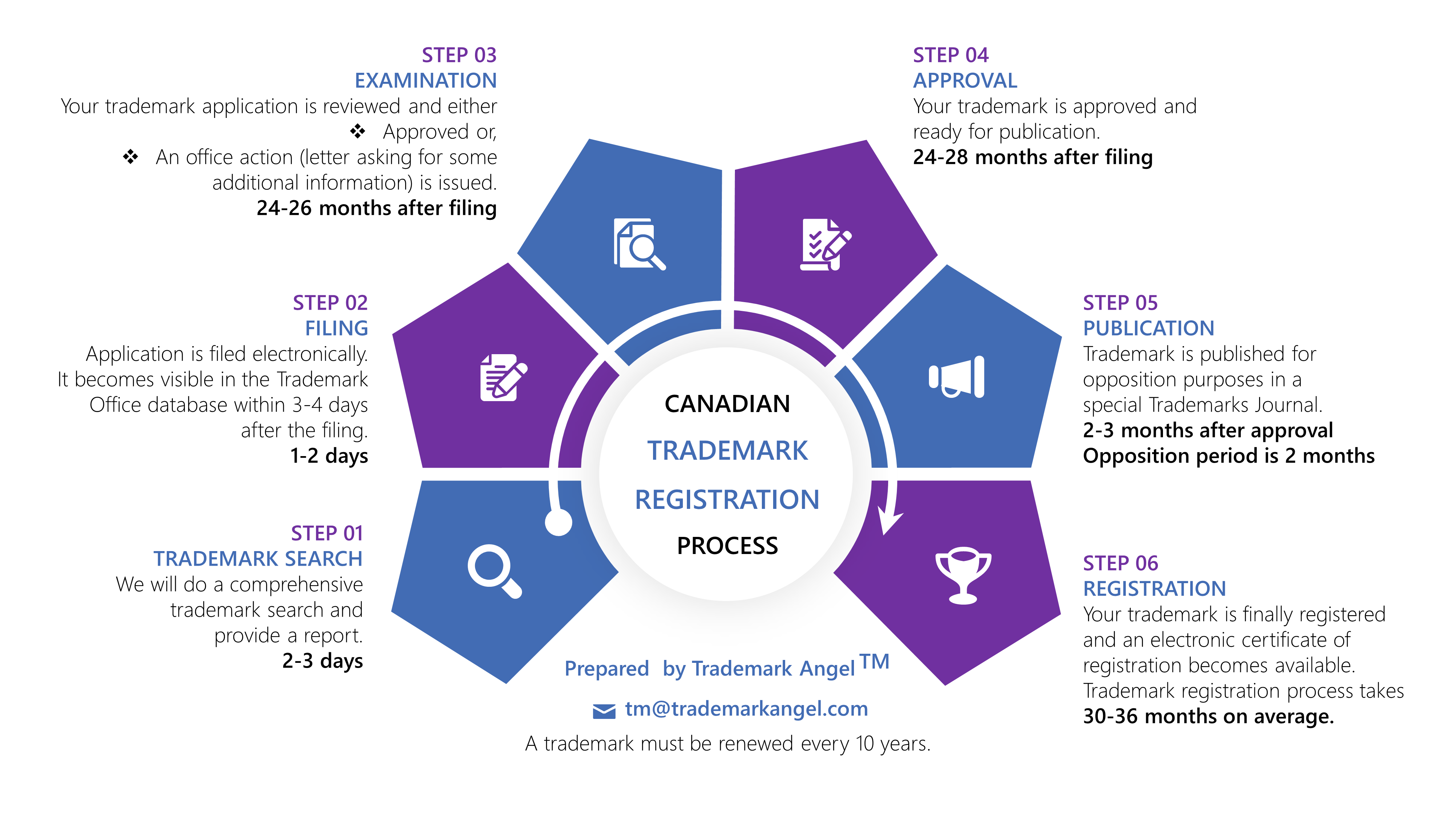 Note: Declarations of use have been eliminated. Currently, once an earlier filed trademark is allowed, the final registration fee needs to be paid. For trademarks filed after June 17, 2017, no registration fee will be necessary.
Note: Declarations of use have been eliminated. Currently, once an earlier filed trademark is allowed, the final registration fee needs to be paid. For trademarks filed after June 17, 2017, no registration fee will be necessary.
To open in a new tab, click: What is the Canadian trademark registration process?




 Then, the logo could provide sufficient distinctiveness to allow registration of TRADEMARK REGISTRATION CO. onto the Principal Register (with a disclaimer for “TRADEMARK REGISTRATION CO.”).
Another situation when filing for a logo is advantageous is when there are similar marks. For example, a client wanted to register the mark HAWQUE with a design element of a flying hawk
Then, the logo could provide sufficient distinctiveness to allow registration of TRADEMARK REGISTRATION CO. onto the Principal Register (with a disclaimer for “TRADEMARK REGISTRATION CO.”).
Another situation when filing for a logo is advantageous is when there are similar marks. For example, a client wanted to register the mark HAWQUE with a design element of a flying hawk  - for computer software connecting customers to security contractors, in Class 9. We advised that the logo will most likely be registrable but the wordmark alone would be too similar to marks containing the word HAWK providing similar products in the same class. Although we received an office action alleging that the HAWQUE logo mark was confusingly similar to a registered wordmark, HAWQ, that also covered Class 9 computer software, we were ultimately able to overcome the objection. Our client’s logo, HAWQUE, was successfully registered soon after.
In another case, a client wanted to register the mark ESTEEM APPAREL, either the word mark or the logo. However, in our initial search, we found a very similar, registered mark, ESTEEM CLOTHING. In this case, we advised that the logo would have a greater chance of registration. The client chose to file for the logo
- for computer software connecting customers to security contractors, in Class 9. We advised that the logo will most likely be registrable but the wordmark alone would be too similar to marks containing the word HAWK providing similar products in the same class. Although we received an office action alleging that the HAWQUE logo mark was confusingly similar to a registered wordmark, HAWQ, that also covered Class 9 computer software, we were ultimately able to overcome the objection. Our client’s logo, HAWQUE, was successfully registered soon after.
In another case, a client wanted to register the mark ESTEEM APPAREL, either the word mark or the logo. However, in our initial search, we found a very similar, registered mark, ESTEEM CLOTHING. In this case, we advised that the logo would have a greater chance of registration. The client chose to file for the logo  instead of the word mark and, although we received a confusion objection based on similarity with ESTEAM and ESTEEM CLOTHING marks, we were able to successfully able to overcome the objection and the mark was successfully registered.
Since the client protected the logo
instead of the word mark and, although we received a confusion objection based on similarity with ESTEAM and ESTEEM CLOTHING marks, we were able to successfully able to overcome the objection and the mark was successfully registered.
Since the client protected the logo  Note: Declarations of use have been eliminated. Currently, once an earlier filed trademark is allowed, the final registration fee needs to be paid. For trademarks filed after June 17, 2017, no registration fee will be necessary.
Note: Declarations of use have been eliminated. Currently, once an earlier filed trademark is allowed, the final registration fee needs to be paid. For trademarks filed after June 17, 2017, no registration fee will be necessary.


